| Listing 1 - 10 of 19 | << page >> |
Sort by
|
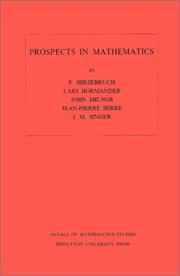
ISBN: 0691080941 9780691080949 1400881692 Year: 1971 Volume: 70 Publisher: Princeton (N.J.) : Princeton university press,
Abstract | Keywords | Export | Availability | Bookmark
 Loading...
Loading...Choose an application
- Reference Manager
- EndNote
- RefWorks (Direct export to RefWorks)
Five papers by distinguished American and European mathematicians describe some current trends in mathematics in the perspective of the recent past and in terms of expectations for the future. Among the subjects discussed are algebraic groups, quadratic forms, topological aspects of global analysis, variants of the index theorem, and partial differential equations.
Mathematics --- Mathématiques --- Congresses --- Congrès --- 51 --- -Math --- Science --- Congresses. --- -Mathematics --- 51 Mathematics --- -51 Mathematics --- Math --- Mathématiques --- Congrès --- A priori estimate. --- Addition. --- Additive group. --- Affine space. --- Algebraic geometry. --- Algebraic group. --- Atiyah–Singer index theorem. --- Bernoulli number. --- Boundary value problem. --- Bounded operator. --- C*-algebra. --- Canonical transformation. --- Cauchy problem. --- Characteristic class. --- Clifford algebra. --- Coefficient. --- Cohomology. --- Commutative property. --- Commutative ring. --- Complex manifold. --- Complex number. --- Complex vector bundle. --- Dedekind sum. --- Degenerate bilinear form. --- Diagram (category theory). --- Diffeomorphism. --- Differentiable manifold. --- Differential operator. --- Dimension (vector space). --- Ellipse. --- Elliptic operator. --- Equation. --- Euler characteristic. --- Euler number. --- Existence theorem. --- Exotic sphere. --- Finite difference. --- Finite group. --- Fourier integral operator. --- Fourier transform. --- Fourier. --- Fredholm operator. --- Hardy space. --- Hilbert space. --- Holomorphic vector bundle. --- Homogeneous coordinates. --- Homomorphism. --- Homotopy. --- Hyperbolic partial differential equation. --- Identity component. --- Integer. --- Integral transform. --- Isomorphism class. --- John Milnor. --- K-theory. --- Lebesgue measure. --- Line bundle. --- Local ring. --- Mathematics. --- Maximal ideal. --- Modular form. --- Module (mathematics). --- Monoid. --- Normal bundle. --- Number theory. --- Open set. --- Parametrix. --- Parity (mathematics). --- Partial differential equation. --- Piecewise linear manifold. --- Poisson bracket. --- Polynomial ring. --- Polynomial. --- Prime number. --- Principal part. --- Projective space. --- Pseudo-differential operator. --- Quadratic form. --- Rational variety. --- Real number. --- Reciprocity law. --- Resolution of singularities. --- Riemann–Roch theorem. --- Shift operator. --- Simply connected space. --- Special case. --- Square-integrable function. --- Subalgebra. --- Submanifold. --- Support (mathematics). --- Surjective function. --- Symmetric bilinear form. --- Symplectic vector space. --- Tangent space. --- Theorem. --- Topology. --- Variable (mathematics). --- Vector bundle. --- Vector space. --- Winding number. --- Mathematics - Congresses
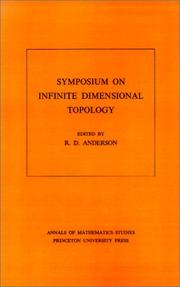
ISBN: 0691080879 1400881404 9780691080871 Year: 1972 Volume: 69 Publisher: Princeton (N.J.) : Princeton university press,
Abstract | Keywords | Export | Availability | Bookmark
 Loading...
Loading...Choose an application
- Reference Manager
- EndNote
- RefWorks (Direct export to RefWorks)
In essence the proceedings of the 1967 meeting in Baton Rouge, the volume offers significant papers in the topology of infinite dimensional linear spaces, fixed point theory in infinite dimensional spaces, infinite dimensional differential topology, and infinite dimensional pointset topology. Later results of the contributors underscore the basic soundness of this selection, which includes survey and expository papers, as well as reports of continuing research.
Topology --- Differential geometry. Global analysis --- Differential topology --- Functional analysis --- Congresses --- Analyse fonctionnnelle --- Geometry, Differential --- Anderson's theorem. --- Annihilator (ring theory). --- Automorphism. --- Baire measure. --- Banach algebra. --- Banach manifold. --- Banach space. --- Bounded operator. --- Cartesian product. --- Characterization (mathematics). --- Cohomology. --- Compact space. --- Complement (set theory). --- Complete metric space. --- Connected space. --- Continuous function. --- Convex set. --- Coset. --- Critical point (mathematics). --- Diagram (category theory). --- Differentiable manifold. --- Differential topology. --- Dimension (vector space). --- Dimension. --- Dimensional analysis. --- Dual space. --- Duality (mathematics). --- Endomorphism. --- Equivalence class. --- Euclidean space. --- Existential quantification. --- Explicit formulae (L-function). --- Exponential map (Riemannian geometry). --- Fixed-point theorem. --- Fréchet derivative. --- Fréchet space. --- Fuchsian group. --- Function space. --- Fundamental class. --- Haar measure. --- Hessian matrix. --- Hilbert space. --- Homeomorphism. --- Homology (mathematics). --- Homotopy group. --- Homotopy. --- Inclusion map. --- Infimum and supremum. --- Lebesgue space. --- Lefschetz fixed-point theorem. --- Limit point. --- Linear space (geometry). --- Locally convex topological vector space. --- Loop space. --- Mathematical optimization. --- Measure (mathematics). --- Metric space. --- Module (mathematics). --- Natural topology. --- Neighbourhood (mathematics). --- Normal space. --- Normed vector space. --- Open set. --- Ordinal number. --- Paracompact space. --- Partition of unity. --- Path space. --- Product topology. --- Quantifier (logic). --- Quotient space (linear algebra). --- Quotient space (topology). --- Radon measure. --- Reflexive space. --- Representation theorem. --- Riemannian manifold. --- Schauder fixed point theorem. --- Sign (mathematics). --- Simply connected space. --- Space form. --- Special case. --- Stiefel manifold. --- Strong operator topology. --- Subcategory. --- Submanifold. --- Subset. --- Tangent space. --- Teichmüller space. --- Theorem. --- Topological space. --- Topological vector space. --- Topology. --- Transfinite induction. --- Transfinite. --- Transversal (geometry). --- Transversality theorem. --- Tychonoff cube. --- Union (set theory). --- Unit sphere. --- Weak topology. --- Weakly compact. --- Differential topology - Congresses --- Functional analysis - Congresses --- Topology - Congresses --- Analyse fonctionnelle.
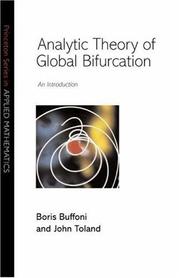
ISBN: 0691112983 1400884330 9781400884339 9780691112985 Year: 2016 Publisher: Princeton, NJ : Princeton University Press,
Abstract | Keywords | Export | Availability | Bookmark
 Loading...
Loading...Choose an application
- Reference Manager
- EndNote
- RefWorks (Direct export to RefWorks)
Rabinowitz's classical global bifurcation theory, which concerns the study in-the-large of parameter-dependent families of nonlinear equations, uses topological methods that address the problem of continuous parameter dependence of solutions by showing that there are connected sets of solutions of global extent. Even when the operators are infinitely differentiable in all the variables and parameters, connectedness here cannot in general be replaced by path-connectedness. However, in the context of real-analyticity there is an alternative theory of global bifurcation due to Dancer, which offers a much stronger notion of parameter dependence. This book aims to develop from first principles Dancer's global bifurcation theory for one-parameter families of real-analytic operators in Banach spaces. It shows that there are globally defined continuous and locally real-analytic curves of solutions. In particular, in the real-analytic setting, local analysis can lead to global consequences--for example, as explained in detail here, those resulting from bifurcation from a simple eigenvalue. Included are accounts of analyticity and implicit function theorems in Banach spaces, classical results from the theory of finite-dimensional analytic varieties, and the links between these two and global existence theory. Laying the foundations for more extensive studies of real-analyticity in infinite-dimensional problems and illustrating the theory with examples, Analytic Theory of Global Bifurcation is intended for graduate students and researchers in pure and applied analysis.
Differential geometry. Global analysis --- Bifurcation theory. --- Differential equations, Nonlinear --- Stability --- Numerical solutions --- Addition. --- Algebraic equation. --- Analytic function. --- Analytic manifold. --- Atmospheric pressure. --- Banach space. --- Bernhard Riemann. --- Bifurcation diagram. --- Boundary value problem. --- Bounded operator. --- Bounded set (topological vector space). --- Boundedness. --- Canonical form. --- Cartesian coordinate system. --- Codimension. --- Compact operator. --- Complex analysis. --- Complex conjugate. --- Complex number. --- Connected space. --- Coordinate system. --- Corollary. --- Curvature. --- Derivative. --- Diagram (category theory). --- Differentiable function. --- Differentiable manifold. --- Dimension (vector space). --- Dimension. --- Direct sum. --- Eigenvalues and eigenvectors. --- Elliptic integral. --- Embedding. --- Equation. --- Euclidean division. --- Euler equations (fluid dynamics). --- Existential quantification. --- First principle. --- Fredholm operator. --- Froude number. --- Functional analysis. --- Hilbert space. --- Homeomorphism. --- Implicit function theorem. --- Integer. --- Linear algebra. --- Linear function. --- Linear independence. --- Linear map. --- Linear programming. --- Linear space (geometry). --- Linear subspace. --- Linearity. --- Linearization. --- Metric space. --- Morse theory. --- Multilinear form. --- N0. --- Natural number. --- Neumann series. --- Nonlinear functional analysis. --- Nonlinear system. --- Numerical analysis. --- Open mapping theorem (complex analysis). --- Operator (physics). --- Ordinary differential equation. --- Parameter. --- Parametrization. --- Partial differential equation. --- Permutation group. --- Permutation. --- Polynomial. --- Power series. --- Prime number. --- Proportionality (mathematics). --- Pseudo-differential operator. --- Puiseux series. --- Quantity. --- Real number. --- Resultant. --- Singularity theory. --- Skew-symmetric matrix. --- Smoothness. --- Solution set. --- Special case. --- Standard basis. --- Sturm–Liouville theory. --- Subset. --- Symmetric bilinear form. --- Symmetric group. --- Taylor series. --- Taylor's theorem. --- Theorem. --- Total derivative. --- Two-dimensional space. --- Union (set theory). --- Variable (mathematics). --- Vector space. --- Zero of a function.

ISBN: 0691082286 0691082324 1400881579 Year: 1979 Publisher: Princeton, N.J.
Abstract | Keywords | Export | Availability | Bookmark
 Loading...
Loading...Choose an application
- Reference Manager
- EndNote
- RefWorks (Direct export to RefWorks)
Based on a seminar sponsored by the Institute for Advanced Study in 1977-1978, this set of papers introduces micro-local analysis concisely and clearly to mathematicians with an analytical background. The papers treat the theory of microfunctions and applications such as boundary values of elliptic partial differential equations, propagation of singularities in the vicinity of degenerate characteristics, holonomic systems, Feynman integrals from the hyperfunction point of view, and harmonic analysis on Lie groups.
Mathematical analysis --- Differential geometry. Global analysis --- 517.98 --- -Advanced calculus --- Analysis (Mathematics) --- Algebra --- Functional analysis and operator theory --- Addresses, essays, lectures --- Mathematical analysis. --- Addresses, essays, lectures. --- -517.1 Mathematical analysis --- 517.98 Functional analysis and operator theory --- -Functional analysis and operator theory --- -517.98 Functional analysis and operator theory --- 517.1 Mathematical analysis --- 517.1. --- 517.1 --- Addition. --- Analytic function. --- Analytic manifold. --- Asymptotic analysis. --- Bernhard Riemann. --- Boundary value problem. --- Bounded operator. --- Cartan subgroup. --- Characterization (mathematics). --- Class function (algebra). --- Closed-form expression. --- Codimension. --- Cohomology. --- Compact space. --- Comparison theorem. --- Contact geometry. --- Continuous function. --- Continuous linear operator. --- Convex hull. --- Cotangent bundle. --- D-module. --- Degenerate bilinear form. --- Diagonal matrix. --- Differentiable manifold. --- Differential operator. --- Dimension (vector space). --- Dimension. --- Elliptic partial differential equation. --- Equation. --- Existence theorem. --- Fourier integral operator. --- Generic point. --- Group theory. --- Harmonic analysis. --- Holomorphic function. --- Holonomic. --- Homogeneous space. --- Hyperfunction. --- Hypersurface. --- Identity element. --- Irreducible representation. --- Killing form. --- Lagrangian (field theory). --- Lie algebra. --- Lie group. --- Linear differential equation. --- Locally compact space. --- Masaki Kashiwara. --- Maximal ideal. --- Monodromy. --- Natural number. --- Neighbourhood (mathematics). --- Ordinary differential equation. --- Orthogonal complement. --- Partial differential equation. --- Path integral formulation. --- Proper map. --- Pseudo-differential operator. --- Regularity theorem. --- Sigurdur Helgason (mathematician). --- Submanifold. --- Subset. --- Summation. --- Symmetric space. --- Symplectic geometry. --- Tangent cone. --- Theorem. --- Topological space. --- Vector bundle. --- Victor Guillemin. --- Weyl group. --- Analyse microlocale

ISBN: 0691032165 140088392X 9780691032160 Year: 1993 Volume: 43 Publisher: Princeton (N.J.): Princeton university press,
Abstract | Keywords | Export | Availability | Bookmark
 Loading...
Loading...Choose an application
- Reference Manager
- EndNote
- RefWorks (Direct export to RefWorks)
This book contains an exposition of some of the main developments of the last twenty years in the following areas of harmonic analysis: singular integral and pseudo-differential operators, the theory of Hardy spaces, Lsup estimates involving oscillatory integrals and Fourier integral operators, relations of curvature to maximal inequalities, and connections with analysis on the Heisenberg group.
Harmonic analysis. Fourier analysis --- Harmonic analysis --- Analyse harmonique --- Harmonic analysis. --- Analysis (Mathematics) --- Functions, Potential --- Potential functions --- Banach algebras --- Calculus --- Mathematical analysis --- Mathematics --- Bessel functions --- Fourier series --- Harmonic functions --- Time-series analysis --- Groupe de Heisenberg. --- Addition. --- Analytic function. --- Asymptote. --- Asymptotic analysis. --- Asymptotic expansion. --- Asymptotic formula. --- Automorphism. --- Axiom. --- Banach space. --- Bessel function. --- Big O notation. --- Bilinear form. --- Borel measure. --- Boundary value problem. --- Bounded function. --- Bounded mean oscillation. --- Bounded operator. --- Boundedness. --- Cancellation property. --- Cauchy's integral theorem. --- Cauchy–Riemann equations. --- Characteristic polynomial. --- Characterization (mathematics). --- Commutative property. --- Commutator. --- Complex analysis. --- Convolution. --- Differential equation. --- Differential operator. --- Dimension (vector space). --- Dimension. --- Dirac delta function. --- Dirichlet problem. --- Elliptic operator. --- Existential quantification. --- Fatou's theorem. --- Fourier analysis. --- Fourier integral operator. --- Fourier inversion theorem. --- Fourier series. --- Fourier transform. --- Fubini's theorem. --- Function (mathematics). --- Fundamental solution. --- Gaussian curvature. --- Hardy space. --- Harmonic function. --- Heisenberg group. --- Hilbert space. --- Hilbert transform. --- Holomorphic function. --- Hölder's inequality. --- Infimum and supremum. --- Integral transform. --- Interpolation theorem. --- Lagrangian (field theory). --- Laplace's equation. --- Lebesgue measure. --- Lie algebra. --- Line segment. --- Linear map. --- Lipschitz continuity. --- Locally integrable function. --- Marcinkiewicz interpolation theorem. --- Martingale (probability theory). --- Mathematical induction. --- Maximal function. --- Meromorphic function. --- Multiplication operator. --- Nilpotent Lie algebra. --- Norm (mathematics). --- Number theory. --- Operator theory. --- Order of integration (calculus). --- Orthogonality. --- Oscillatory integral. --- Poisson summation formula. --- Projection (linear algebra). --- Pseudo-differential operator. --- Pseudoconvexity. --- Rectangle. --- Riesz transform. --- Several complex variables. --- Sign (mathematics). --- Singular integral. --- Sobolev space. --- Special case. --- Spectral theory. --- Square (algebra). --- Stochastic differential equation. --- Subharmonic function. --- Submanifold. --- Summation. --- Support (mathematics). --- Theorem. --- Translational symmetry. --- Uniqueness theorem. --- Variable (mathematics). --- Vector field. --- Fourier, Analyse de --- Fourier, Opérateurs intégraux de
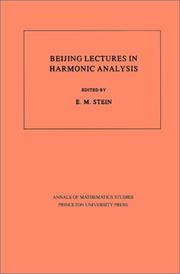
ISBN: 0691084181 069108419X 1400882095 Year: 1986 Publisher: Princeton (N.J.) Princeton University Press
Abstract | Keywords | Export | Availability | Bookmark
 Loading...
Loading...Choose an application
- Reference Manager
- EndNote
- RefWorks (Direct export to RefWorks)
Based on seven lecture series given by leading experts at a summer school at Peking University, in Beijing, in 1984. this book surveys recent developments in the areas of harmonic analysis most closely related to the theory of singular integrals, real-variable methods, and applications to several complex variables and partial differential equations. The different lecture series are closely interrelated; each contains a substantial amount of background material, as well as new results not previously published. The contributors to the volume are R. R. Coifman and Yves Meyer, Robert Fcfferman,Carlos K. Kenig, Steven G. Krantz, Alexander Nagel, E. M. Stein, and Stephen Wainger.
Harmonic analysis. --- Analysis (Mathematics) --- Functions, Potential --- Potential functions --- Banach algebras --- Calculus --- Mathematical analysis --- Mathematics --- Bessel functions --- Fourier series --- Harmonic functions --- Time-series analysis --- Analytic function. --- Asymptotic formula. --- Bergman metric. --- Bernhard Riemann. --- Bessel function. --- Biholomorphism. --- Boundary value problem. --- Bounded mean oscillation. --- Bounded operator. --- Boundedness. --- Cauchy's integral formula. --- Characteristic function (probability theory). --- Characterization (mathematics). --- Coefficient. --- Commutator. --- Complexification (Lie group). --- Continuous function. --- Convolution. --- Degeneracy (mathematics). --- Differential equation. --- Differential operator. --- Dirac delta function. --- Dirichlet problem. --- Equation. --- Estimation. --- Existence theorem. --- Existential quantification. --- Explicit formula. --- Explicit formulae (L-function). --- Fatou's theorem. --- Fourier analysis. --- Fourier integral operator. --- Fourier transform. --- Fredholm theory. --- Fubini's theorem. --- Function (mathematics). --- Functional calculus. --- Fundamental solution. --- Gaussian curvature. --- Hardy space. --- Harmonic function. --- Harmonic measure. --- Heisenberg group. --- Hilbert space. --- Hilbert transform. --- Hodge theory. --- Holomorphic function. --- Hyperbolic partial differential equation. --- Hölder's inequality. --- Infimum and supremum. --- Integration by parts. --- Interpolation theorem. --- Intersection (set theory). --- Invertible matrix. --- Isometry group. --- Laplace operator. --- Laplace's equation. --- Lebesgue measure. --- Linear map. --- Lipschitz continuity. --- Lipschitz domain. --- Lp space. --- Mathematical induction. --- Mathematical physics. --- Maximal function. --- Maximum principle. --- Measure (mathematics). --- Newtonian potential. --- Non-Euclidean geometry. --- Number theory. --- Operator theory. --- Oscillatory integral. --- Parameter. --- Partial derivative. --- Partial differential equation. --- Polynomial. --- Power series. --- Product metric. --- Radon–Nikodym theorem. --- Riemannian manifold. --- Riesz representation theorem. --- Scientific notation. --- Several complex variables. --- Sign (mathematics). --- Simultaneous equations. --- Singular function. --- Singular integral. --- Sobolev space. --- Square (algebra). --- Statistical hypothesis testing. --- Stokes' theorem. --- Support (mathematics). --- Tangent space. --- Tensor product. --- Theorem. --- Trigonometric series. --- Uniformization theorem. --- Variable (mathematics). --- Vector field.
Book
ISBN: 0691080747 1322884773 0691621411 0691648077 1400868572 9780691080741 Year: 1970 Publisher: Princeton: Princeton university press,
Abstract | Keywords | Export | Availability | Bookmark
 Loading...
Loading...Choose an application
- Reference Manager
- EndNote
- RefWorks (Direct export to RefWorks)
Encompassing both introductory and more advanced research material, these notes deal with the author's contributions to stochastic processes and focus on Brownian motion processes and its derivative white noise.Originally published in 1970.The Princeton Legacy Library uses the latest print-on-demand technology to again make available previously out-of-print books from the distinguished backlist of Princeton University Press. These editions preserve the original texts of these important books while presenting them in durable paperback and hardcover editions. The goal of the Princeton Legacy Library is to vastly increase access to the rich scholarly heritage found in the thousands of books published by Princeton University Press since its founding in 1905.
Stationary processes --- Stationary processes. --- Stochastic processes --- 519.216 --- 519.216 Stochastic processes in general. Prediction theory. Stopping times. Martingales --- Stochastic processes in general. Prediction theory. Stopping times. Martingales --- Bochner integral. --- Bochner's theorem. --- Bounded operator. --- Bounded variation. --- Brownian motion. --- Characteristic exponent. --- Characteristic function (probability theory). --- Complexification. --- Compound Poisson process. --- Computation. --- Conditional expectation. --- Continuous function (set theory). --- Continuous function. --- Continuous linear operator. --- Convergence of random variables. --- Coset. --- Covariance function. --- Cyclic subspace. --- Cylinder set. --- Degrees of freedom (statistics). --- Derivative. --- Differential equation. --- Dimension (vector space). --- Dirac delta function. --- Discrete spectrum. --- Distribution function. --- Dual space. --- Eigenfunction. --- Equation. --- Existential quantification. --- Exponential distribution. --- Exponential function. --- Finite difference. --- Fourier series. --- Fourier transform. --- Function (mathematics). --- Function space. --- Gaussian measure. --- Gaussian process. --- Harmonic analysis. --- Hermite polynomials. --- Hilbert space. --- Homeomorphism. --- Independence (probability theory). --- Independent and identically distributed random variables. --- Indicator function. --- Infinitesimal generator (stochastic processes). --- Integral equation. --- Isometry. --- Joint probability distribution. --- Langevin equation. --- Lebesgue measure. --- Lie algebra. --- Limit superior and limit inferior. --- Linear combination. --- Linear function. --- Linear interpolation. --- Linear subspace. --- Mean squared error. --- Measure (mathematics). --- Monotonic function. --- Normal distribution. --- Normal subgroup. --- Nuclear space. --- One-parameter group. --- Orthogonality. --- Orthogonalization. --- Parameter. --- Poisson point process. --- Polynomial. --- Probability distribution. --- Probability measure. --- Probability space. --- Probability. --- Projective linear group. --- Radon–Nikodym theorem. --- Random function. --- Random variable. --- Reproducing kernel Hilbert space. --- Self-adjoint operator. --- Self-adjoint. --- Semigroup. --- Shift operator. --- Special case. --- Stable process. --- Stationary process. --- Stochastic differential equation. --- Stochastic process. --- Stochastic. --- Subgroup. --- Summation. --- Symmetrization. --- Theorem. --- Transformation semigroup. --- Unitary operator. --- Unitary representation. --- Unitary transformation. --- Variance. --- White noise. --- Zero element.
Book
ISBN: 0691082472 0691601097 1400870488 0691630852 Year: 1979 Publisher: Princeton, N.J.
Abstract | Keywords | Export | Availability | Bookmark
 Loading...
Loading...Choose an application
- Reference Manager
- EndNote
- RefWorks (Direct export to RefWorks)
The theory of pseudo-differential operators (which originated as singular integral operators) was largely influenced by its application to function theory in one complex variable and regularity properties of solutions of elliptic partial differential equations. Given here is an exposition of some new classes of pseudo-differential operators relevant to several complex variables and certain non-elliptic problems.Originally published in 1979.The Princeton Legacy Library uses the latest print-on-demand technology to again make available previously out-of-print books from the distinguished backlist of Princeton University Press. These editions preserve the original texts of these important books while presenting them in durable paperback and hardcover editions. The goal of the Princeton Legacy Library is to vastly increase access to the rich scholarly heritage found in the thousands of books published by Princeton University Press since its founding in 1905.
517.982.4 --- Pseudodifferential operators --- Operators, Pseudodifferential --- Pseudo-differential operators --- Theory of generalized functions (distributions) --- Pseudodifferential operators. --- 517.982.4 Theory of generalized functions (distributions) --- Operator theory --- Differential equations, Partial --- Équations aux dérivées partielles --- Opérateurs pseudo-différentiels --- Addition. --- Adjoint. --- Approximation. --- Asymptotic expansion. --- Banach space. --- Bounded operator. --- Boundedness. --- Calculation. --- Change of variables. --- Coefficient. --- Compact space. --- Complex analysis. --- Computation. --- Corollary. --- Cotangent bundle. --- Derivative. --- Differential operator. --- Disjoint union. --- Elliptic partial differential equation. --- Estimation. --- Euclidean distance. --- Euclidean vector. --- Existential quantification. --- Fourier integral operator. --- Fourier transform. --- Geometric series. --- Heat equation. --- Heisenberg group. --- Homogeneous distribution. --- Infimum and supremum. --- Integer. --- Integration by parts. --- Intermediate value theorem. --- Jacobian matrix and determinant. --- Left inverse. --- Linear combination. --- Linear map. --- Mean value theorem. --- Monograph. --- Monomial. --- Nilpotent group. --- Operator (physics). --- Operator norm. --- Order of magnitude. --- Orthogonal complement. --- Parametrix. --- Parity (mathematics). --- Partition of unity. --- Polynomial. --- Projection (linear algebra). --- Pseudo-differential operator. --- Quadratic function. --- Regularity theorem. --- Remainder. --- Requirement. --- Right inverse. --- Scientific notation. --- Self-reference. --- Several complex variables. --- Singular integral. --- Smoothness. --- Sobolev space. --- Special case. --- Submanifold. --- Subset. --- Sum of squares. --- Summation. --- Support (mathematics). --- Tangent space. --- Taylor's theorem. --- Theorem. --- Theory. --- Transpose. --- Triangle inequality. --- Uniform boundedness. --- Upper and lower bounds. --- Variable (mathematics). --- Without loss of generality. --- Zero set. --- Équations aux dérivées partielles --- Opérateurs pseudo-différentiels
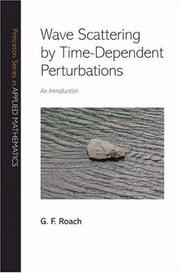
ISBN: 1282158783 9786612158780 1400828163 9781400828166 9781282158788 9780691113401 0691113408 6612158786 Year: 2007 Publisher: Princeton, N.J. : Princeton University Press,
Abstract | Keywords | Export | Availability | Bookmark
 Loading...
Loading...Choose an application
- Reference Manager
- EndNote
- RefWorks (Direct export to RefWorks)
This book offers the first comprehensive introduction to wave scattering in nonstationary materials. G. F. Roach's aim is to provide an accessible, self-contained resource for newcomers to this important field of research that has applications across a broad range of areas, including radar, sonar, diagnostics in engineering and manufacturing, geophysical prospecting, and ultrasonic medicine such as sonograms. New methods in recent years have been developed to assess the structure and properties of materials and surfaces. When light, sound, or some other wave energy is directed at the material in question, "imperfections" in the resulting echo can reveal a tremendous amount of valuable diagnostic information. The mathematics behind such analysis is sophisticated and complex. However, while problems involving stationary materials are quite well understood, there is still much to learn about those in which the material is moving or changes over time. These so-called non-autonomous problems are the subject of this fascinating book. Roach develops practical strategies, techniques, and solutions for mathematicians and applied scientists working in or seeking entry into the field of modern scattering theory and its applications. Wave Scattering by Time-Dependent Perturbations is destined to become a classic in this rapidly evolving area of inquiry.
Waves --- Scattering (Physics) --- Perturbation (Mathematics) --- Perturbation equations --- Perturbation theory --- Approximation theory --- Dynamics --- Functional analysis --- Mathematical physics --- Atomic scattering --- Atoms --- Nuclear scattering --- Particles (Nuclear physics) --- Scattering of particles --- Wave scattering --- Collisions (Nuclear physics) --- Particles --- Collisions (Physics) --- Cycles --- Hydrodynamics --- Benjamin-Feir instability --- Mathematics. --- Scattering --- Acoustic wave equation. --- Acoustic wave. --- Affine space. --- Angular frequency. --- Approximation. --- Asymptotic analysis. --- Asymptotic expansion. --- Banach space. --- Basis (linear algebra). --- Bessel's inequality. --- Boundary value problem. --- Bounded operator. --- C0-semigroup. --- Calculation. --- Characteristic function (probability theory). --- Classical physics. --- Codimension. --- Coefficient. --- Continuous function (set theory). --- Continuous function. --- Continuous spectrum. --- Convolution. --- Differentiable function. --- Differential equation. --- Dimension (vector space). --- Dimension. --- Dimensional analysis. --- Dirac delta function. --- Dirichlet problem. --- Distribution (mathematics). --- Duhamel's principle. --- Eigenfunction. --- Eigenvalues and eigenvectors. --- Electromagnetism. --- Equation. --- Existential quantification. --- Exponential function. --- Floquet theory. --- Fourier inversion theorem. --- Fourier series. --- Fourier transform. --- Fredholm integral equation. --- Frequency domain. --- Helmholtz equation. --- Hilbert space. --- Initial value problem. --- Integral equation. --- Integral transform. --- Integration by parts. --- Inverse problem. --- Inverse scattering problem. --- Lebesgue measure. --- Linear differential equation. --- Linear map. --- Linear space (geometry). --- Locally integrable function. --- Longitudinal wave. --- Mathematical analysis. --- Mathematical physics. --- Metric space. --- Operator theory. --- Ordinary differential equation. --- Orthonormal basis. --- Orthonormality. --- Parseval's theorem. --- Partial derivative. --- Partial differential equation. --- Phase velocity. --- Plane wave. --- Projection (linear algebra). --- Propagator. --- Quantity. --- Quantum mechanics. --- Reflection coefficient. --- Requirement. --- Riesz representation theorem. --- Scalar (physics). --- Scattering theory. --- Scattering. --- Scientific notation. --- Self-adjoint operator. --- Self-adjoint. --- Series expansion. --- Sine wave. --- Spectral method. --- Spectral theorem. --- Spectral theory. --- Square-integrable function. --- Subset. --- Theorem. --- Theory. --- Time domain. --- Time evolution. --- Unbounded operator. --- Unitarity (physics). --- Vector space. --- Volterra integral equation. --- Wave function. --- Wave packet. --- Wave propagation.
Book
ISBN: 9781400862887 1400862884 0691635412 0691606706 9780691635415 9780691606705 Year: 2014 Publisher: Princeton, NJ : Princeton University Press,
Abstract | Keywords | Export | Availability | Bookmark
 Loading...
Loading...Choose an application
- Reference Manager
- EndNote
- RefWorks (Direct export to RefWorks)
In Hypo-Analytic Structures Franois Treves provides a systematic approach to the study of the differential structures on manifolds defined by systems of complex vector fields. Serving as his main examples are the elliptic complexes, among which the De Rham and Dolbeault are the best known, and the tangential Cauchy-Riemann operators. Basic geometric entities attached to those structures are isolated, such as maximally real submanifolds and orbits of the system. Treves discusses the existence, uniqueness, and approximation of local solutions to homogeneous and inhomogeneous equations and delimits their supports. The contents of this book consist of many results accumulated in the last decade by the author and his collaborators, but also include classical results, such as the Newlander-Nirenberg theorem. The reader will find an elementary description of the FBI transform, as well as examples of its use. Treves extends the main approximation and uniqueness results to first-order nonlinear equations by means of the Hamiltonian lift.Originally published in 1993.The Princeton Legacy Library uses the latest print-on-demand technology to again make available previously out-of-print books from the distinguished backlist of Princeton University Press. These editions preserve the original texts of these important books while presenting them in durable paperback and hardcover editions. The goal of the Princeton Legacy Library is to vastly increase access to the rich scholarly heritage found in the thousands of books published by Princeton University Press since its founding in 1905.
Differential equations, Partial. --- Manifolds (Mathematics) --- Vector fields. --- Direction fields (Mathematics) --- Fields, Direction (Mathematics) --- Fields, Slope (Mathematics) --- Fields, Vector --- Slope fields (Mathematics) --- Vector analysis --- Geometry, Differential --- Topology --- Partial differential equations --- Algebra homomorphism. --- Analytic function. --- Automorphism. --- Basis (linear algebra). --- Bijection. --- Bounded operator. --- C0. --- CR manifold. --- Cauchy problem. --- Cauchy sequence. --- Cauchy–Riemann equations. --- Characterization (mathematics). --- Coefficient. --- Cohomology. --- Commutative property. --- Commutator. --- Complex dimension. --- Complex manifold. --- Complex number. --- Complex space. --- Complex-analytic variety. --- Continuous function (set theory). --- Corollary. --- Coset. --- De Rham cohomology. --- Diagram (category theory). --- Diffeomorphism. --- Differential form. --- Differential operator. --- Dimension (vector space). --- Dirac delta function. --- Dirac measure. --- Eigenvalues and eigenvectors. --- Embedding. --- Equation. --- Exact differential. --- Existential quantification. --- Exterior algebra. --- F-space. --- Formal power series. --- Frobenius theorem (differential topology). --- Frobenius theorem (real division algebras). --- H-vector. --- Hadamard three-circle theorem. --- Hahn–Banach theorem. --- Holomorphic function. --- Hypersurface. --- Hölder condition. --- Identity matrix. --- Infimum and supremum. --- Integer. --- Integral equation. --- Integral transform. --- Intersection (set theory). --- Jacobian matrix and determinant. --- Linear differential equation. --- Linear equation. --- Linear map. --- Lipschitz continuity. --- Manifold. --- Mean value theorem. --- Method of characteristics. --- Monomial. --- Multi-index notation. --- Neighbourhood (mathematics). --- Norm (mathematics). --- One-form. --- Open mapping theorem (complex analysis). --- Open mapping theorem. --- Open set. --- Ordinary differential equation. --- Partial differential equation. --- Poisson bracket. --- Polynomial. --- Power series. --- Projection (linear algebra). --- Pullback (category theory). --- Pullback (differential geometry). --- Pullback. --- Riemann mapping theorem. --- Riemann surface. --- Ring homomorphism. --- Sesquilinear form. --- Sobolev space. --- Special case. --- Stokes' theorem. --- Stone–Weierstrass theorem. --- Submanifold. --- Subset. --- Support (mathematics). --- Surjective function. --- Symplectic geometry. --- Symplectic vector space. --- Taylor series. --- Theorem. --- Unit disk. --- Upper half-plane. --- Vector bundle. --- Vector field. --- Volume form.
| Listing 1 - 10 of 19 | << page >> |
Sort by
|

 Search
Search Feedback
Feedback About UniCat
About UniCat  Help
Help News
News